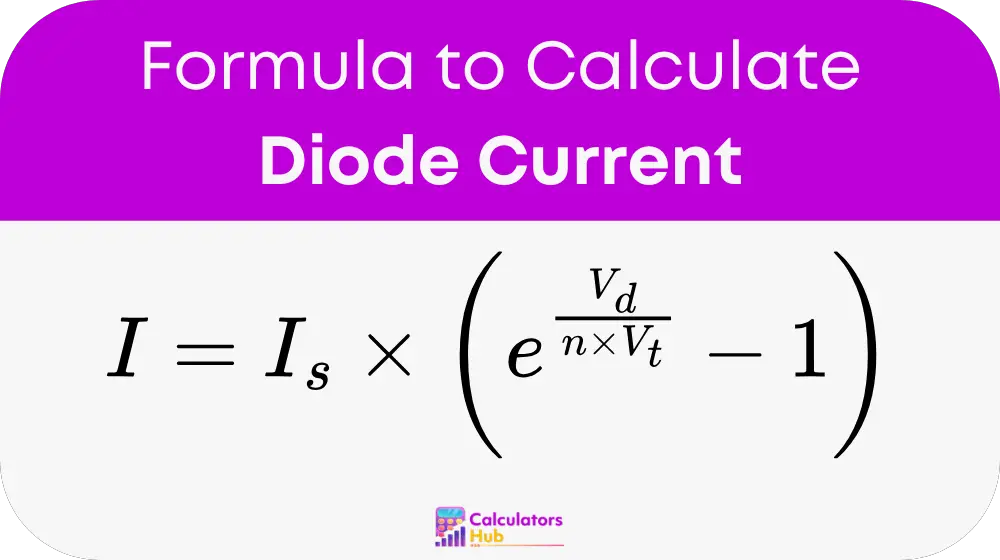The Diode Current Calculator helps determine the amount of current flowing through a diode when a certain voltage is applied across it. This calculation is essential for designing and analyzing circuits involving diodes, such as rectifiers, signal processing, and power regulation in various electronic devices.
By using this calculator, engineers and students can quickly compute the diode current in scenarios involving forward-biased diodes. This simplifies the analysis of diode performance and ensures accurate component selection in circuits.
Formula of Diode Current Calculator
The formula used to calculate the current through a diode is based on the Shockley diode equation:

where:
- I (Diode Current) is the current flowing through the diode (in amperes).
- I_s (Saturation Current) is the small leakage current when the diode is reverse-biased (in amperes).
- V_d (Diode Voltage) is the applied voltage across the diode (in volts).
- n (Ideality Factor) is a constant (typically between 1 and 2) that depends on the diode material.
- V_t (Thermal Voltage) is given by the equation V_t = kT/q, where:
- k (Boltzmann's Constant) = 1.38 × 10⁻²³ J/K
- T (Temperature in Kelvin) = Room temperature is typically 300K
- q (Charge of an Electron) = 1.602 × 10⁻¹⁹ C
- V_t at Room Temperature ≈ 25.85 mV
This equation helps calculate the diode current based on the voltage, saturation current, and thermal properties of the diode, as well as its material properties.
General Terms for Diode Current Calculation
Below is a table explaining common terms involved in diode current calculation:
| Term | Symbol | Definition |
|---|---|---|
| Diode Current | I | The current flowing through the diode (in amperes). |
| Saturation Current | I_s | The small reverse leakage current when the diode is reverse-biased. |
| Diode Voltage | V_d | The applied voltage across the diode (in volts). |
| Ideality Factor | n | A constant (typically between 1 and 2) that depends on the diode material. |
| Thermal Voltage | V_t | The voltage related to temperature, approximately 25.85mV at room temperature (300K). |
| Boltzmann Constant | k | A constant used in thermal voltage calculation: 1.38 × 10⁻²³ J/K. |
| Electron Charge | q | The charge of an electron: 1.602 × 10⁻¹⁹ C. |
This table provides essential definitions for understanding and applying the diode current calculation formula.
Example of Diode Current Calculator
Example 1: Calculating Diode Current at Room Temperature
Suppose we have a diode with a saturation current (I_s) of 10⁻¹² A, an applied voltage (V_d) of 0.7 V, and an ideality factor (n) of 1.5. The thermal voltage at room temperature (T = 300 K) is 25.85 mV.
Using the diode current formula:
I = I_s × (e^(V_d / (n × V_t)) - 1)
Substituting the given values:
I = 10⁻¹² × (e^(0.7 / (1.5 × 25.85 × 10⁻³)) - 1)
First, calculate the thermal voltage:
V_t = 25.85 mV = 0.02585 V
Then:
n × V_t = 1.5 × 0.02585 = 0.038775
V_d / (n × V_t) = 0.7 / 0.038775 = 18.06
e^18.06 ≈ 6.52 × 10⁷
e^18.06 - 1 ≈ 6.52 × 10⁷
I = 10⁻¹² × 6.52 × 10⁷
I ≈ 6.52 × 10⁻⁵ A
Therefore, the diode current is approximately 65.2 μA.
Example 2: Diode Current Calculation for LED
For an LED diode with I_s = 10⁻¹⁴ A, V_d = 2.1 V, and n = 1.2, the diode current at room temperature can be calculated similarly.
Most Common FAQs
When choosing a diode, ensure that its saturation current (I_s) and voltage ratings align with the circuit’s requirements. Additionally, the ideality factor (n) should be considered for accuracy in the current calculation, especially for more precise applications.
Temperature impacts the thermal voltage (V_t) and saturation current (I_s), causing the diode current to change with temperature. As the temperature increases, V_t increases, and I_s typically doubles for every 10°C rise.
Exceeding the maximum current rating of the diode can lead to damage or failure of the diode due to excessive heat or breakdown of the semiconductor material. Always ensure the current is within the rated limits to avoid circuit failure.